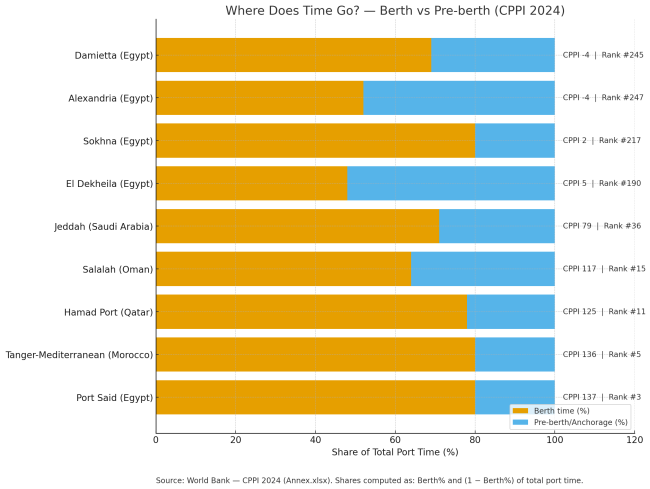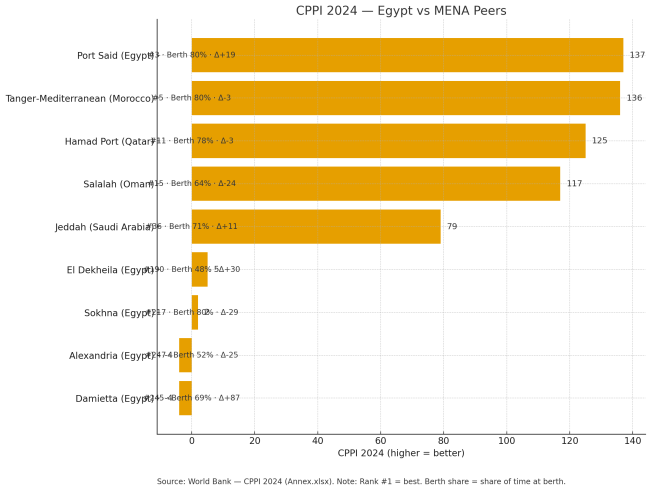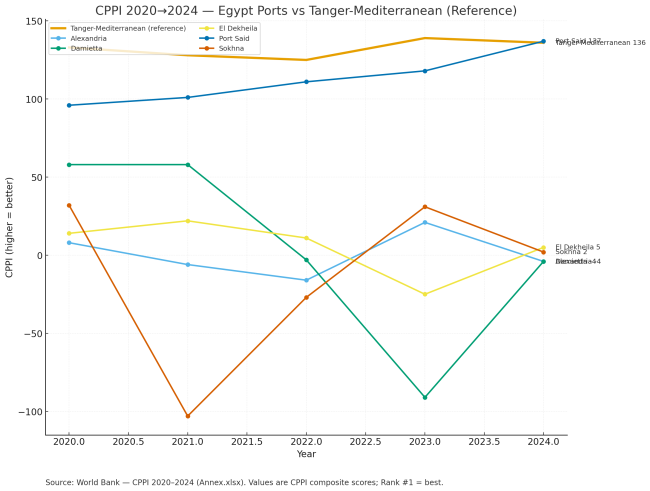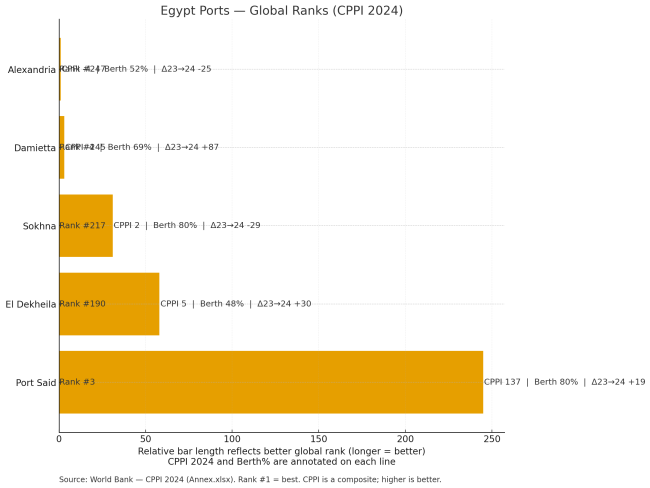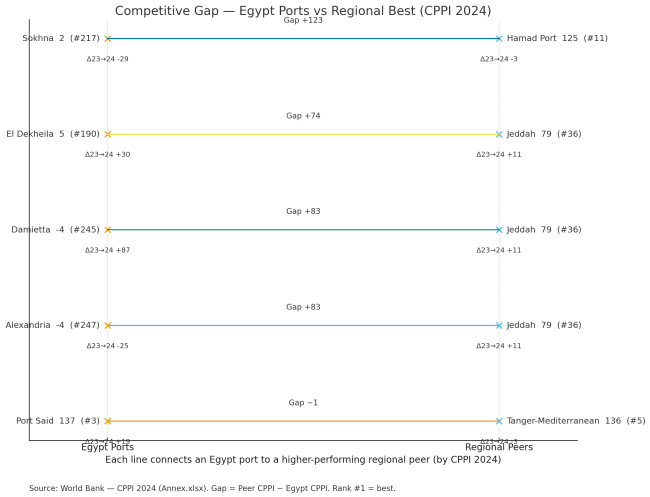Container Port Performance Index (CPPI) 2020–2024 – 2025: Global Performance Analysis ▸ Egypt’s Posi
Container Port Performance Index (CPPI) 2020–2024 – 2025: Global Performance Analysis ▸ Egypt’s Position ▸ Reform Roadmap
Evidence-based reading of CPPI 2025 (covering 2024): data card and methodology, global & MENA trends, Egypt’s placement with numbers, concise tables, and measurable priorities for the next 6–24 months.
1. Overview
The CPPI provides an operational benchmark of port efficiency based on the ship’s total time in port (from arrival to berth departure), with comparisons normalized for vessel size and call size. Results draw on AIS and operational timestamps from major carriers, blending administrative and statistical lenses. The 2025 release covers 2024 data and tracks five-year trends 2020→2024, highlighting improvements following supply-chain disruptions.
2. Data Card
- Name (AR/EN): مؤشر أداء موانئ الحاويات 2020–2024: اتجاهات ودروس مستفادة / The Container Port Performance Index 2020 to 2024: Trends and Lessons Learned
- Issuer: World Bank – Global Transport Practice (in partnership with S&P Global Market Intelligence)
- Latest edition (label): 2025 (covering 2024) – within Mobility & Transport Connectivity series
- Frequency / Type / Status: Annual ▸ Index with rankings ▸ Active ✅
- Official files: PDF report + Annex.xlsx (source of the tables and figures)
3. Methodology & Dimensions (brief)
- Main measure: Total time in port = (pre-berth/anchorage) + (berth time).
- Comparability: Like-for-like comparisons by vessel-size bands and call-size segments.
- Aggregation: Blend of administrative index and statistical index (factor analysis).
- Auxiliary signal: Berth share (berth hours ÷ total port hours) as a proxy for operational effectiveness.
Distribution of
total port time between
berth time and
pre‑berth/anchorage for selected Egyptian ports versus regional peers in
CPPI 2024. Leading ports (Port Said/Tanger‑Med/Hamad) show higher berth shares (~80%), implying lower waiting and tighter window management.
4. Global & Regional Trends
Global (2024): Continued rise of specialized ports with disciplined berth window management and just‑in‑time arrivals.
MENA references: Tanger‑Med within the top 5 globally (rank 5, CPPI=136, berth≈80%); Hamad (rank 11, CPPI=125); Salalah (rank 15, CPPI=117); Jeddah (rank 36, CPPI=79).
Placement of Egyptian ports against regional benchmarks in
CPPI 2024 (higher is better).
Port Said rises to
#3 globally with a score of
137 and a
berth share of 80%, while El Dekheila/Sokhna/Damietta/Alexandria register gaps that call for near‑term operational fixes.
Five‑year
CPPI trajectories (
2020→2024) for five Egyptian ports compared to
Tanger‑Med. Port Said climbs to
137 in 2024 (surpassing the reference at
136), whereas Alexandria/Damietta/El Dekheila/Sokhna show mixed paths.
5. Egypt — Facts
Port Said leads domestically with a standout global outcome: #3 worldwide (CPPI=137, Δ23→24=+19, berth≈80%). Other Egyptian ports sit lower and vary significantly: El Dekheila (rank 190, CPPI=5); Sokhna (rank 217, CPPI=2); Damietta (rank 245, CPPI=−4); Alexandria (rank 247, CPPI=−4).
Global ranks of Egyptian ports in CPPI 2024 with supportive signals: CPPI score, berth share, and 2023→2024 change. Longer bars reflect better ranks.
Table 1 — Egypt (2024 snapshot)
| Port | CPPI 2023 | CPPI 2024 | Δ 2023→2024 | Global rank | Berth share |
| Port Said |
118 |
137 |
+19 |
3 |
0.80 |
| El Dekheila |
-25 |
5 |
+30 |
190 |
0.48 |
| Sokhna |
31 |
2 |
−29 |
217 |
0.80 |
| Damietta |
-91 |
-4 |
+87 |
245 |
0.69 |
| Alexandria |
21 |
-4 |
−25 |
247 |
0.52 |
Table 2 — Regional peers (MENA)
| Peer port | CPPI 2023 | CPPI 2024 | Δ 2023→2024 | Global rank | Berth share |
| Tanger‑Mediterranean (MAR) |
139 |
136 |
−3 |
5 |
0.80 |
| Hamad Port (QAT) |
128 |
125 |
−3 |
11 |
0.78 |
| Salalah (OMN) |
141 |
117 |
−24 |
15 |
0.64 |
| Jeddah (SAU) |
68 |
79 |
+11 |
36 |
0.71 |
Method note: CPPI is a composite (higher is better). Global ranking: #1 = best.
Each Egyptian port is connected to a higher‑performing regional peer to visualize the
gap to close. Port Said’s gap to Tanger‑Med is marginal (−1), while larger gaps appear for Alexandria/Damietta/El Dekheila (vs Jeddah) and Sokhna (vs Hamad).
7. Performance Gaps & Priority Actions (Top 5)
- Pre‑berth waiting: schedule slippage and fuel burn → JIT arrival + enforceable berth windows.
- Berth productivity variance: inconsistent service quality → align crane density to call size.
- Marine services coordination: sequential delays → multi‑party service‑level agreements.
- Limited real‑time transparency: reactive decisions → activate PCS and data sharing.
- Shock exposure: year‑to‑year volatility → tested contingency scenarios.
8. Reform Roadmap (6–24 months)
| Action | Lead / partners | KPI | Timeframe |
| Implement JIT arrival and manage berth windows |
Egyptian ports + shipping agents |
Reduce P50 pre‑berth waiting (%) |
6–12 months |
| Align crane density to call size |
Ports / terminal operators |
Increase moves/hour (+X%) |
6–12 months |
| Activate PCS and integrate agencies |
Port + Customs + Carriers |
Cut document‑cycle time (−X%) |
12–18 months |
| Marine services coordination program |
Ports + Pilotage/Tugs |
Lower process time variance (−σ) |
6–12 months |
| Shock‑readiness plan |
Ports + Crisis unit |
Post‑shock recovery time (↓) |
12–24 months |
Quick linkage: Egypt Vision 2030 (Economy, Innovation & Knowledge) and SDGs 9/8/12.
9. Focused Conclusion
CPPI 2024 underscores Port Said’s excellence (#3 globally) and highlights actionable gaps elsewhere addressable through JIT, berth‑window management, crane alignment, and PCS. ENCC will track quarterly impacts and calibrate recommendations as the official annex updates.
Selected Official References
- World Bank — The Container Port Performance Index 2020 to 2024: Trends and Lessons Learned (PDF)
- CPPI 2020–2024 — Annex.xlsx (source tables and operational analytics)
